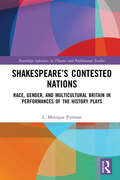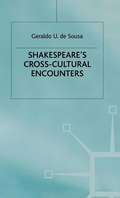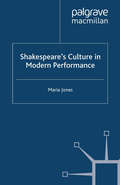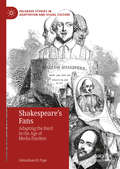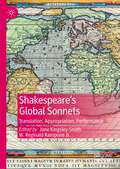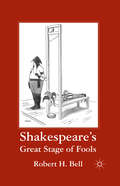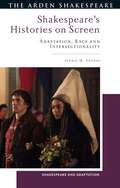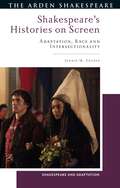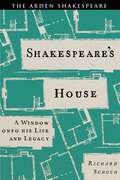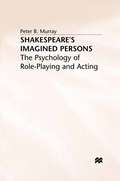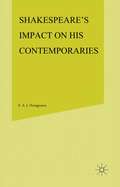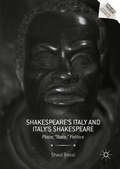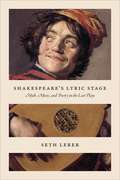- Table View
- List View
Shakespeare’s Contested Nations: Race, Gender, and Multicultural Britain in Performances of the History Plays (Routledge Advances in Theatre & Performance Studies)
by L. Monique PittmanShakespeare’s Contested Nations argues that performances of Shakespearean history at British institutional venues between 2000 and 2016 manifest a post-imperial nostalgia that fails to tell the nation’s story in ways that account for the agential impact of women and people of color, thus foreclosing promising opportunities to re-examine the nation’s multicultural past, present, and future in more intentional, self-critical, and truly progressive ways. A cluster of interconnected stage and televisual performances and adaptations of the history play canon illustrate the function that Shakespeare’s narratives of incipient "British" identities fulfill for the postcolonial United Kingdom. The book analyzes treatments of the plays in a range of styles—staged performances directed by Michael Boyd with the Royal Shakespeare Company (2000–2001) and Nicholas Hytner at the National Theatre (2003, 2005), the BBC’s Hollow Crown series (2012, 2016), the RSC and BBC adaptations of Wolf Hall and Bring Up the Bodies (2013, 2015), and a contemporary reinterpretation of the canon, Mike Bartlett’s King Charles III (2014, 2017). This book will be of great interest to scholars and students of Shakespeare, theatre, and politics.
Shakespeare’s Contested Nations: Race, Gender, and Multicultural Britain in Performances of the History Plays (Routledge Advances in Theatre & Performance Studies)
by L. Monique PittmanShakespeare’s Contested Nations argues that performances of Shakespearean history at British institutional venues between 2000 and 2016 manifest a post-imperial nostalgia that fails to tell the nation’s story in ways that account for the agential impact of women and people of color, thus foreclosing promising opportunities to re-examine the nation’s multicultural past, present, and future in more intentional, self-critical, and truly progressive ways. A cluster of interconnected stage and televisual performances and adaptations of the history play canon illustrate the function that Shakespeare’s narratives of incipient "British" identities fulfill for the postcolonial United Kingdom. The book analyzes treatments of the plays in a range of styles—staged performances directed by Michael Boyd with the Royal Shakespeare Company (2000–2001) and Nicholas Hytner at the National Theatre (2003, 2005), the BBC’s Hollow Crown series (2012, 2016), the RSC and BBC adaptations of Wolf Hall and Bring Up the Bodies (2013, 2015), and a contemporary reinterpretation of the canon, Mike Bartlett’s King Charles III (2014, 2017). This book will be of great interest to scholars and students of Shakespeare, theatre, and politics.
Shakespeare's Cross-Cultural Encounters
by Geraldo U. De SousaIn this highly entertaining study, De Sousa argues that Shakespeare reinterprets, refashions and reinscribes his alien characters - Jews, Moors, Amazons and gypsies. In this way, the dramatist questions the narrowness of a European perspective which caricatures other societies and views them with suspicion. De Sousa examines how Shakespeare defines other cultures in terms of the interplay of gender, text and habitat. Written in a provocative style, this readable book provides a wealth of fascinating information both on contemporary stage productions and on race and gender relations in early modern Europe.
Shakespeare’s Culture in Modern Performance
by M. JonesShakespeare's Culture in Modern Performance is an original study at the interface of a historicizing literary criticism and the study of modern performance. In a critical climate that views the cultural object of performance as authentic in itself, is there any point in exploring a script's original history? The writer argues for a dialogic understanding of Shakespeare's plays in performance relative to unresolved issues of modernity, in a study of modern productions on stage and screen.
Shakespeare's Early Comedies
by Eustace M. TillyardOf all that has been written recently on Shakespearean comedy much is cross-sectional; much has pursued themes, patterns, images and son on, recurring throughout the sequence of plays. Less has been written about he plays themselves. There are of course the introductions to new editions; and there have been articles on this or that play: but any books surveying the whole sequence of the comedies have done so with some one special matter in mind. Thus, there may be room for a book like this; one that deals with the comedies primarily as plays, as separate entities. But such treatments need not exclude comment on the background and on how one play is linked with another; and I shall not avoid these matters.
Shakespeare’s Fans: Adapting the Bard in the Age of Media Fandom (Palgrave Studies in Adaptation and Visual Culture)
by Johnathan H. PopeThis book examines Shakespearean adaptations through the critical lens of fan studies and asks what it means to be a fan of Shakespeare in the context of contemporary media fandom. Although Shakespeare studies and fan studies have remained largely separate from one another for the past thirty years, this book establishes a sustained dialogue between the two fields. In the process, it reveals and seeks to overcome the problematic assumptions about the history of fan cultures, Shakespeare’s place in that history, and how fan works are defined. While fandom is normally perceived as a recent phenomenon focused primarily on science fiction and fantasy, this book traces fans’ practices back to the eighteenth century, particularly David Garrick’s Shakespeare Jubilee in 1769. Shakespeare’s Fans connects historical and scholarly debates over who owns Shakespeare and what constitutes an appropriate adaptation of his work to online fan fiction and commercially available fan works.
Shakespeare’s Global Sonnets: Translation, Appropriation, Performance (Global Shakespeares)
by Jane Kingsley-Smith W. Reginald Rampone Jr.This edited collection brings together scholars from across the world, including France, Italy, Germany, Hungary, Japan, the USA and India, to offer a truly international perspective on the global reception of Shakespeare’s Sonnets from the 18th century to the present. Global Shakespeare has never been so local and familiar as it is today. The translation, appropriation and teaching of Shakespeare’s plays across the world have been the subject of much important recent work in Shakespeare studies, as have the ethics of Shakespeare’s globalization. Within this discussion, however, the Sonnets are often overlooked. This book offers a new global history of the Sonnets, including the first substantial study of their translation and of their performance in theatre, music and film. It will appeal to anyone interested in the reception of the Sonnets, and of Shakespeare across the world.
Shakespeare's Great Stage of Fools
by R. BellThis lively, lucid book undertakes a detailed and provocative study of Shakespeare's fascination with clowns, fools, and fooling. Through close reading of plays over the whole course of Shakespeare's theatrical career, Bell highlights the fun, wit, insights, and mysteries of some of Shakespeare's most vibrant and often vexing figures.
Shakespeare's Heartbeat: Drama games for children with autism
by Kelly HunterChildren on the autistic spectrum experience varying degrees of difficulties; all of which can be understood as a disassociation of mind and body. Expressing feelings, making eye contact, keeping a steady heartbeat and recognizing faces are all part of the autism dilemma which can be poetically explored by Shakespeare. Over ten years, Hunter worked with children on all points of the spectrum, developing drama games for the specific purpose of combatting autism. These unique games, derived from specific moments in the plays, shed new light on how to teach Shakespeare to children, using the drama as an exploration of how it feels to be alive. Shakespeare’s Heartbeat is a step-by-step guide, detailing how to demonstrate, play and share these sensory games. The book includes: Games based on A Midsummer Night’s Dream Games based on The Tempest Tips and advice for playing one-on-one with the children An afterword describing Hunter’s journey from performer and practitioner to creator of this work. Shakespeare’s poetic definitions of seeing, thinking and loving reveal the very processes that children with autism find so difficult to achieve. This book provides an indispensable learning tool for those wishing to encourage children’s eye contact and facial expression, improve their spatial awareness and language skills and introduce them to imaginative play.
Shakespeare's Heartbeat: Drama games for children with autism
by Kelly HunterChildren on the autistic spectrum experience varying degrees of difficulties; all of which can be understood as a disassociation of mind and body. Expressing feelings, making eye contact, keeping a steady heartbeat and recognizing faces are all part of the autism dilemma which can be poetically explored by Shakespeare. Over ten years, Hunter worked with children on all points of the spectrum, developing drama games for the specific purpose of combatting autism. These unique games, derived from specific moments in the plays, shed new light on how to teach Shakespeare to children, using the drama as an exploration of how it feels to be alive. Shakespeare’s Heartbeat is a step-by-step guide, detailing how to demonstrate, play and share these sensory games. The book includes: Games based on A Midsummer Night’s Dream Games based on The Tempest Tips and advice for playing one-on-one with the children An afterword describing Hunter’s journey from performer and practitioner to creator of this work. Shakespeare’s poetic definitions of seeing, thinking and loving reveal the very processes that children with autism find so difficult to achieve. This book provides an indispensable learning tool for those wishing to encourage children’s eye contact and facial expression, improve their spatial awareness and language skills and introduce them to imaginative play.
Shakespeare’s histories and counter-histories
by Dermot Cavanagh Stephen Longstaffe Stuart Hampton-ReevesShakespeare's history plays have always been pivotal to our understanding of his works. This collection renews attention to these crucial plays by exploring official and unofficial versions of the past, histories and counter-histories in the plays of Shakespeare and his contemporaries. By exploring the diversity of Shakespeare’s engagement with history in all its forms, these contributors open up a range of new interpretive possibilities for understanding the way history ‘plays’ with the past. The book is divided into three sections: Memory and mourning, Counter-histories, Identity and performance. In each section, leading theorists, historicists and performance critics offer fresh perspectives on the key issues that are transforming our understanding of Shakespeare. These include: gender and violence, the mapping of Britain, cultural memory and religion. This collection will appeal to all critically engaged readers of Shakespeare. In particular it will command wide-ranging interest from undergraduates, postgraduates, academic researchers and students of early modern theatre, history and culture.
Shakespeare’s Histories on Screen: Adaptation, Race and Intersectionality (Shakespeare and Adaptation)
by Jennie M. VotavaThis volume reframes the critical conversation about Shakespeare's histories and national identity by bringing together two growing bodies of work: early modern race scholarship and adaptation theory. Theorizing a link between adaptation and intersectionality, it demonstrates how over the past thirty years race has become a central and constitutive part of British and American screen adaptations of the English histories. Available to expanding audiences via digital media platforms, these adaptations interrogate the dialectic between Shakespeare's cultural capital and racial reckonings on both sides of the Atlantic and across time. By engaging contemporary representations of race, ethnicity, gender, sexuality, disability and class, adaptation not only creates artefacts that differ from their source texts, but also facilitates the conditions in which race and its intersections in the plays become visible. At the centre of this analysis stand two landmark 21st-century history adaptations that use non-traditional casting: the British TV miniseries The Hollow Crown (2012, 2016) and the American independent film H4 (2012), an all-Black Henry IV conflation. In addition to demonstrating how the 21st-century screen history illuminates both past and present constructions of embodied difference, these works provide a lens for reassessing two history adaptations from Shakespeare's 1990s box office renaissance, when actors of colour were first cast in cinematic versions of the plays. As exemplified by these formal adaptations' reappropriations of race in history, non-traditional Shakespearean casting practices are also currently shaping digital culture's conversations about race in non-Shakespearean period dramas such as Bridgerton.
Shakespeare’s Histories on Screen: Adaptation, Race and Intersectionality (Shakespeare and Adaptation)
by Jennie M. VotavaThis volume reframes the critical conversation about Shakespeare's histories and national identity by bringing together two growing bodies of work: early modern race scholarship and adaptation theory. Theorizing a link between adaptation and intersectionality, it demonstrates how over the past thirty years race has become a central and constitutive part of British and American screen adaptations of the English histories. Available to expanding audiences via digital media platforms, these adaptations interrogate the dialectic between Shakespeare's cultural capital and racial reckonings on both sides of the Atlantic and across time. By engaging contemporary representations of race, ethnicity, gender, sexuality, disability and class, adaptation not only creates artefacts that differ from their source texts, but also facilitates the conditions in which race and its intersections in the plays become visible. At the centre of this analysis stand two landmark 21st-century history adaptations that use non-traditional casting: the British TV miniseries The Hollow Crown (2012, 2016) and the American independent film H4 (2012), an all-Black Henry IV conflation. In addition to demonstrating how the 21st-century screen history illuminates both past and present constructions of embodied difference, these works provide a lens for reassessing two history adaptations from Shakespeare's 1990s box office renaissance, when actors of colour were first cast in cinematic versions of the plays. As exemplified by these formal adaptations' reappropriations of race in history, non-traditional Shakespearean casting practices are also currently shaping digital culture's conversations about race in non-Shakespearean period dramas such as Bridgerton.
Shakespeare’s Hobby-Horse and Early Modern Popular Culture (Studies in Performance and Early Modern Drama)
by Natália PikliThis book explores the ways in which the early modern hobby-horse featured in different productions of popular culture between the 1580s and 1630s. Natália Pikli approaches this study with a thorough and interdisciplinary examination of hobby-horse references, with commentary on the polysemous uses of the word, offers an informative background to reconsider well-known texts by Shakespeare and others, and provides an overview on the workings of cultural memory regarding popular culture in early modern England. The book will appeal to those with interest in early modern drama and theatre, dramaturgy, popular culture, cultural memory, and iconography.
Shakespeare’s Hobby-Horse and Early Modern Popular Culture (Studies in Performance and Early Modern Drama)
by Natália PikliThis book explores the ways in which the early modern hobby-horse featured in different productions of popular culture between the 1580s and 1630s. Natália Pikli approaches this study with a thorough and interdisciplinary examination of hobby-horse references, with commentary on the polysemous uses of the word, offers an informative background to reconsider well-known texts by Shakespeare and others, and provides an overview on the workings of cultural memory regarding popular culture in early modern England. The book will appeal to those with interest in early modern drama and theatre, dramaturgy, popular culture, cultural memory, and iconography.
Shakespeare’s House: A Window onto his Life and Legacy
by Professor Richard SchochIn the wide realm of Shakespeare worship, the house in Stratford-upon-Avon where William Shakespeare was born in 1564 – known colloquially as the 'Birthplace' – remains the chief shrine. It's not as romantic as Anne Hathaway's thatched cottage, it's not where he wrote any of his plays, and there's nothing inside the house that once belonged to Shakespeare himself. So why, for centuries, have people kept turning up on the doorstep? Richard Schoch answers that question by examining the history of the Birthplace and by exploring how its changing fortunes over four centuries perfectly mirror the changing attitudes toward Shakespeare himself.Based on original research in the archives of the Shakespeare Birthplace Trust in Stratford-upon-Avon and the Folger Shakespeare Library in Washington, DC, and featuring two black and white illustrated plate sections which draw on the wide array of material available at the Folger Shakespeare Library and the Victoria and Albert Museum, this book traces the history of Shakespeare's birthplace over four centuries. Beginning in the 1560s, when Shakespeare was born there, it ends in the 1890s, when the house was rescued from private purchase and turned into the Shakespeare monument that it remains today.
Shakespeare’s House: A Window onto his Life and Legacy
by Professor Richard SchochIn the wide realm of Shakespeare worship, the house in Stratford-upon-Avon where William Shakespeare was born in 1564 – known colloquially as the 'Birthplace' – remains the chief shrine. It's not as romantic as Anne Hathaway's thatched cottage, it's not where he wrote any of his plays, and there's nothing inside the house that once belonged to Shakespeare himself. So why, for centuries, have people kept turning up on the doorstep? Richard Schoch answers that question by examining the history of the Birthplace and by exploring how its changing fortunes over four centuries perfectly mirror the changing attitudes toward Shakespeare himself.Based on original research in the archives of the Shakespeare Birthplace Trust in Stratford-upon-Avon and the Folger Shakespeare Library in Washington, DC, and featuring two black and white illustrated plate sections which draw on the wide array of material available at the Folger Shakespeare Library and the Victoria and Albert Museum, this book traces the history of Shakespeare's birthplace over four centuries. Beginning in the 1560s, when Shakespeare was born there, it ends in the 1890s, when the house was rescued from private purchase and turned into the Shakespeare monument that it remains today.
Shakespeare’s Imagined Persons: The Psychology of Role-Playing and Acting
by P. MurrayChallenging our understanding of ideas about psychology in Shakespeare's time, Shakespeare's Imagined Persons proposes we should view his characters as imagined persons. A new reading of B.F. Skinner's radical behaviourism brings out how - contrary to the impression he created - Skinner ascribes an important role in human behaviour to cognitive activity. Using this analysis, Peter Murray demonstrates the consistency of radical behaviourism with the psychology of character formation and acting in writers from Plato to Shakespeare - an approach little explored in the current debates about subjectivity in Elizabethan culture. Murray also shows that radical behaviourism can explain the phenomena observed in modern studies of acting and social role-playing. Drawing on these analyses of earlier and modern psychology, Murray goes on to reveal the dynamics of Shakespeare's characterizations of Hamlet, Prince Hal, Rosalind, and Perdita in a fascinating new light.
Shakespeare’s Italy and Italy’s Shakespeare: Place, "Race," Politics (Reproducing Shakespeare)
by Shaul BassiShaul Bassi is Associate Professor of English and Postcolonial Literature at Ca'Foscari University of Venice, Italy. His publications include Visions of Venice in Shakespeare, with Laura Tosi, and Experiences of Freedom in Postcolonial Literatures and Cultures, with Annalisa Oboe.
Shakespeare's Lyric Stage: Myth, Music, and Poetry in the Last Plays
by Seth LererWhat does it mean to have an emotional response to poetry and music? And, just as important but considered less often, what does it mean not to have such a response? What happens when lyric utterances—which should invite consolation, revelation, and connection—somehow fall short of the listener’s expectations? As Seth Lerer shows in this pioneering book, Shakespeare’s late plays invite us to contemplate that very question, offering up lyric as a displaced and sometimes desperate antidote to situations of duress or powerlessness. Lerer argues that the theme of lyric misalignment running throughout The Tempest, The Winter’s Tale, Henry VIII, and Cymbeline serves a political purpose, a last-ditch effort at transformation for characters and audiences who had lived through witch-hunting, plague, regime change, political conspiracies, and public executions. A deep dive into the relationship between aesthetics and politics, this book also explores what Shakespearean lyric is able to recuperate for these “victims of history” by virtue of its disjointed utterances. To this end, Lerer establishes the concept of mythic lyricism: an estranging use of songs and poetry that functions to recreate the past as present, to empower the mythic dead, and to restore a bit of magic to the commonplaces and commodities of Jacobean England. Reading against the devotion to form and prosody common in Shakespeare scholarship, Lerer’s account of lyric utterance’s vexed role in his late works offers new ways to understand generational distance and cultural change throughout the playwright’s oeuvre.
Shakespeare's Lyric Stage: Myth, Music, and Poetry in the Last Plays
by Seth LererWhat does it mean to have an emotional response to poetry and music? And, just as important but considered less often, what does it mean not to have such a response? What happens when lyric utterances—which should invite consolation, revelation, and connection—somehow fall short of the listener’s expectations? As Seth Lerer shows in this pioneering book, Shakespeare’s late plays invite us to contemplate that very question, offering up lyric as a displaced and sometimes desperate antidote to situations of duress or powerlessness. Lerer argues that the theme of lyric misalignment running throughout The Tempest, The Winter’s Tale, Henry VIII, and Cymbeline serves a political purpose, a last-ditch effort at transformation for characters and audiences who had lived through witch-hunting, plague, regime change, political conspiracies, and public executions. A deep dive into the relationship between aesthetics and politics, this book also explores what Shakespearean lyric is able to recuperate for these “victims of history” by virtue of its disjointed utterances. To this end, Lerer establishes the concept of mythic lyricism: an estranging use of songs and poetry that functions to recreate the past as present, to empower the mythic dead, and to restore a bit of magic to the commonplaces and commodities of Jacobean England. Reading against the devotion to form and prosody common in Shakespeare scholarship, Lerer’s account of lyric utterance’s vexed role in his late works offers new ways to understand generational distance and cultural change throughout the playwright’s oeuvre.
Shakespeare's Lyric Stage: Myth, Music, and Poetry in the Last Plays
by Seth LererWhat does it mean to have an emotional response to poetry and music? And, just as important but considered less often, what does it mean not to have such a response? What happens when lyric utterances—which should invite consolation, revelation, and connection—somehow fall short of the listener’s expectations? As Seth Lerer shows in this pioneering book, Shakespeare’s late plays invite us to contemplate that very question, offering up lyric as a displaced and sometimes desperate antidote to situations of duress or powerlessness. Lerer argues that the theme of lyric misalignment running throughout The Tempest, The Winter’s Tale, Henry VIII, and Cymbeline serves a political purpose, a last-ditch effort at transformation for characters and audiences who had lived through witch-hunting, plague, regime change, political conspiracies, and public executions. A deep dive into the relationship between aesthetics and politics, this book also explores what Shakespearean lyric is able to recuperate for these “victims of history” by virtue of its disjointed utterances. To this end, Lerer establishes the concept of mythic lyricism: an estranging use of songs and poetry that functions to recreate the past as present, to empower the mythic dead, and to restore a bit of magic to the commonplaces and commodities of Jacobean England. Reading against the devotion to form and prosody common in Shakespeare scholarship, Lerer’s account of lyric utterance’s vexed role in his late works offers new ways to understand generational distance and cultural change throughout the playwright’s oeuvre.
Shakespeare's Lyric Stage: Myth, Music, and Poetry in the Last Plays
by Seth LererWhat does it mean to have an emotional response to poetry and music? And, just as important but considered less often, what does it mean not to have such a response? What happens when lyric utterances—which should invite consolation, revelation, and connection—somehow fall short of the listener’s expectations? As Seth Lerer shows in this pioneering book, Shakespeare’s late plays invite us to contemplate that very question, offering up lyric as a displaced and sometimes desperate antidote to situations of duress or powerlessness. Lerer argues that the theme of lyric misalignment running throughout The Tempest, The Winter’s Tale, Henry VIII, and Cymbeline serves a political purpose, a last-ditch effort at transformation for characters and audiences who had lived through witch-hunting, plague, regime change, political conspiracies, and public executions. A deep dive into the relationship between aesthetics and politics, this book also explores what Shakespearean lyric is able to recuperate for these “victims of history” by virtue of its disjointed utterances. To this end, Lerer establishes the concept of mythic lyricism: an estranging use of songs and poetry that functions to recreate the past as present, to empower the mythic dead, and to restore a bit of magic to the commonplaces and commodities of Jacobean England. Reading against the devotion to form and prosody common in Shakespeare scholarship, Lerer’s account of lyric utterance’s vexed role in his late works offers new ways to understand generational distance and cultural change throughout the playwright’s oeuvre.
Shakespeare's Lyric Stage: Myth, Music, and Poetry in the Last Plays
by Seth LererWhat does it mean to have an emotional response to poetry and music? And, just as important but considered less often, what does it mean not to have such a response? What happens when lyric utterances—which should invite consolation, revelation, and connection—somehow fall short of the listener’s expectations? As Seth Lerer shows in this pioneering book, Shakespeare’s late plays invite us to contemplate that very question, offering up lyric as a displaced and sometimes desperate antidote to situations of duress or powerlessness. Lerer argues that the theme of lyric misalignment running throughout The Tempest, The Winter’s Tale, Henry VIII, and Cymbeline serves a political purpose, a last-ditch effort at transformation for characters and audiences who had lived through witch-hunting, plague, regime change, political conspiracies, and public executions. A deep dive into the relationship between aesthetics and politics, this book also explores what Shakespearean lyric is able to recuperate for these “victims of history” by virtue of its disjointed utterances. To this end, Lerer establishes the concept of mythic lyricism: an estranging use of songs and poetry that functions to recreate the past as present, to empower the mythic dead, and to restore a bit of magic to the commonplaces and commodities of Jacobean England. Reading against the devotion to form and prosody common in Shakespeare scholarship, Lerer’s account of lyric utterance’s vexed role in his late works offers new ways to understand generational distance and cultural change throughout the playwright’s oeuvre.
